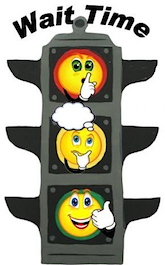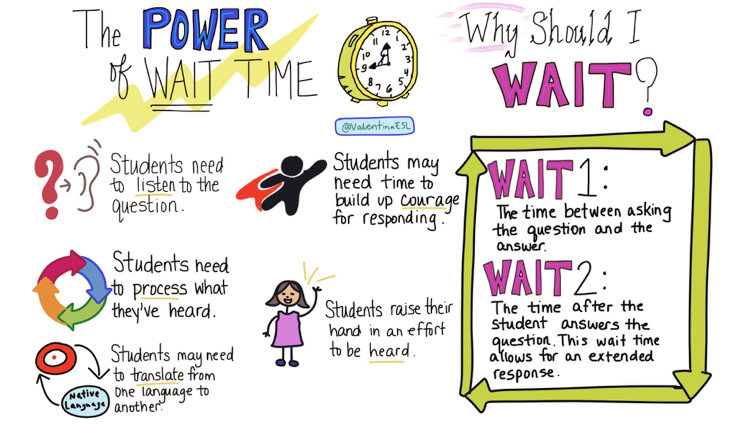Wait Time Can Make or Break Your Lesson
A MiddleWeb Blog
 Wait Time…it can make or break a lesson. How can something so simple have such an incredible impact? It’s the difference between a student fully being engaged and participating and a student becoming frustrated and checking out.
Wait Time…it can make or break a lesson. How can something so simple have such an incredible impact? It’s the difference between a student fully being engaged and participating and a student becoming frustrated and checking out.
Like many effective ELL strategies, “Wait Time” is good teaching practice across the board. It supports special needs students, introverts, and many others who are struggling to keep up academically (see the resources at the end of this post).
Here, I want to look more closely at the impact of wait time for English Language Learners.
Why wait?
When students are learning a new language, they benefit from time to listen to the question and process what they’ve heard. Many students need additional time to take the words they heard and translate them in order to comprehend the message. Once they understand the question, they need time to formulate a response in English and build the courage to use their voice.
Not all ELLs find this an easy task. For me personally, as a young ELL, this was the most difficult part of the equation and exactly where I got stuck. I couldn’t find the courage within the wait time I was given. But if a student has built up enough courage they will raise their hand and hopefully be called on to respond.
TIP: To lower the affective filter of ELLs and help them build the courage to respond, embrace a growth mindset about language learning. Even if the response is not grammatically correct, it’s the risk and the learning that are important. Never publicly correct an ELL’s grammar. The best way to help students who make a grammatical error is to recast.
For example, if a student says, “The water evaporate because of heat,” you can simply respond by saying something like, “Yes, the water evaporated because of the heat.”
How ELLs react without enough Wait Time
When we don’t give enough Wait Time for all of this to happen, we shut our ELLs down before they move past translating what we’ve said. At this point some will get frustrated. Others will tune us out. Many will start to think that the questions are not for them, so why should they listen?
Wait Time is a clear message to all of our students that the lesson and the learning are for them. They are important, and we will not give up on them. Waiting an extra 3-5 seconds after asking a question seems like a small thing to do, but it has large outcomes. Research by Mary Budd Rowe says that when we implement this extra wait time, student responses increase significantly.
Rowe defined wait time as the time between when the teacher asks a question and the student responds. This is also called Wait Time 1. She found that, traditionally, wait time has been less that 1.5 seconds. However, by doubling wait time to 3 seconds, several positive effects were experienced:
- the length of responses increased
- the correctness of responses increased
- more students volunteered answers
- “I don’t know” responses decreased
- student confidence increased
Even teacher behaviors benefit from extended wait time. The quality of teachers’ questions increases while the number of questions asked decreases. Quality over quantity!
Now add Wait Time 2 to support learning
Wait Time 2 is the time after the student responds and the teacher replies. Waiting an additional few seconds here can elicit an extended response from students. In some cases, the teacher may nod or give an “umm.” A nonverbal signal that the teacher is considering allows students an opportunity to continue responding. Students may not always be able to add any additional information, but Wait Time 2 is an opportunity for extra output and elaboration.
Scenario 1:
Teacher: Samantha, why did the water evaporate?
Samantha: Because of the heat.
The rest of the class: They are all thinking…Why should we waste our energy on thinking about an answer or focusing on what the teacher is saying right now? She’s talking to Samantha anyway, not us. So they check out.
Scenario 2 with Wait Time:

Students: (Think, stand, share, sit)
Teacher: Samantha, why did the water evaporate?
Samantha: The water evaporated because of the heat.
Teacher: (nods and looks up as if thinking – Wait Time 2) Hmmm…
Samantha: Heat from the hot plate evaporated the water just like the sun’s heat evaporates water outside when there’s a puddle.
In the new version, the teacher implemented Wait Time 1 and Wait Time 2. During Wait Time 1, all students had an opportunity to think about the answer to the question. Everyone was involved in the questioning and answering.
When the teacher offers a sentence stem, students can more readily respond to the content in the question. The stem is not required, rather it is there to help students who need an extra push to get their thoughts going.
Asking students to stand when they are ready to share, gives everyone time to formulate a response. This way no one is caught off guard.
When I was in high school, I had a teacher who always asked the off-task student to answer a question. It seemed like her goal was to embarrass the kid who wasn’t paying attention. We know now that this type of questioning does not support learning. It doesn’t make students want to learn or make them feel safe.
Partner sharing
Creating a safe environment that supports learning and risk taking is important. Instead of just calling on one student to respond, allowing everyone to share first with a partner gets 100% participation. All kids are talking and listening.

In Scenario 2 above, Samantha had already shared with a partner, so she was warmed up and had an idea from her partner if she needed it.
Since the teacher nodded and made a “thinking sound” – and didn’t cut Samantha off right after her initial response – she was given a second Wait Time. This allowed Samantha to extend her response. Wait Time 2 leaves the door open for students to continue their thoughts.
Small change – Big rewards!
For additional information on teaching with Wait Time, here are a couple of good resources:
► Using Think Time by Robert Stahl
► A New Rhythm for Responding by Beth Sattes & Jackie Walsh




































Thanks for sharing this. I liked the idea of “wait time 2”; I already use wait time in my class; I can see how the second wait time can enhance students’ responses. As a Spanish bilingual teacher, much of what you say here also applies to my students.
Thank you for the comments! Great to know.
Yes, wait time is so important and teachers need to practice because it doesn’t come naturally!
I’d like to print this article and save it but I only get the stuff next to the article and not the article itself. Can you send it to me? I think it’s excellent.
Hi, Marilyn
I’ll make a Word version and email it to you. Susan at MiddleWeb
Can you make a word PDF for me as well so I can print and save it? Thank you
Hi, Grace, I’ll send it over now. Susan
Valentina, you offer teachers such fantastic solutions for working with English Learners. Your experience as an EL makes your articles 3-dimensional.
I did a model teach for a teacher during a coaching session of a math lesson. She spoke very quickly with an accent from another part of the US. Subsequently, her EL students could not understand what she said. When she asked a question, none of her emergent to intermediate students raised their hands. In fact, maybe only about 7 did so.
It was my turn to teach and I asked the question at a more normal rate of speech. Then I did a Think Pair Share on each of the questions. I gave a lot of wait time during the ‘think’ time. Then I gave time for speaking with their partners. When I asked them to raise their hands, nearly every hand went up and with great excitement. She was shocked and very excited herself. She incorporated it into every lesson, catching herself when she forgot or spoke too fast.
Wait time is an often-forgotten ingredient of engagement. If we allow kids to think before they have to share their thoughts with anyone, they have time to do the translating you spoke of in your article. Thank you so much for this.
Sorry for my delayed response to your comment, Anne. But thank you for the testimony on the power of wait time! What a great way to model for the teachers you work with. I’m glad you shared this.
With your permission, I would love to use your image of wait time in a presentation I am doing on creating cultures of thinking. I am a Instructional Coach in Canada.
Thanks,
Julie
Thank you for asking, Julie. Yes, you may use the image. Good luck with your presentation. Valentina